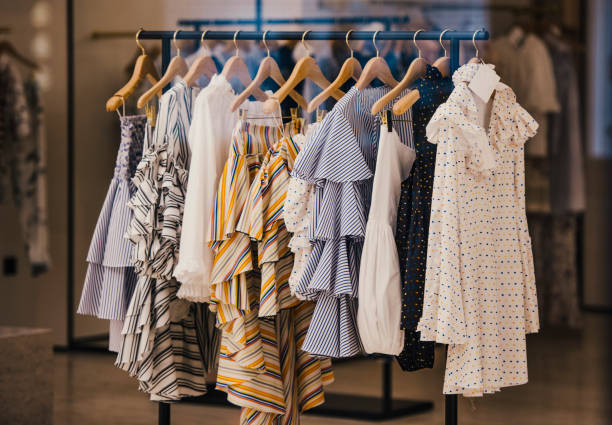Top 10 Essential Item from Your Fave Boutique Fashion Shops
Top 10 Essential Item from Your Fave Boutique Fashion Shops
Blog Article
Lasting Fashion: Exactly How Eco-Friendly Clothing Is Forming the Future of Design
As the fashion sector deals with boosting examination over its ecological impact, the rise of lasting fashion uses a promising choice that lines up style with ecological duty. Utilizing cutting-edge products such as recycled fibers and plant-based textiles, along with sophisticated approaches like electronic and 3D printing, developers are redefining what it implies to be fashionable in the modern-day age. Concurrently, the growing appeal of upcycling and thrift society is cultivating a change towards a round economic climate. Yet, just how does this motion genuinely affect the future trajectory of fashion, and what difficulties lie ahead in its widespread fostering?
Cutting-edge Lasting Materials
As the fashion market grapples with its ecological impact, cutting-edge lasting materials have emerged as an essential solution for reducing eco-friendly footprints. Amongst the most appealing materials are those stemmed from natural, renewable resources, such as natural cotton, hemp, and bamboo. These products not just decrease reliance on fossil gas but also reduce damaging chemical use and water consumption. Organic cotton, for example, uses significantly less water than standard cotton and eliminates the need for hazardous chemicals, therefore preserving soil health and biodiversity.
In enhancement to plant-based materials, innovations in biofabrication have led to the advancement of lab-grown fabrics. Mycelium leather, stemmed from mushroom roots, presents a versatile and naturally degradable alternative to pet natural leather. Its production leads to substantially lower carbon exhausts and water usage, making it a much more lasting choice for fashion designers seeking to line up with environment-friendly practices.
Recycled products are additionally acquiring traction, with polyester made from recycled plastic containers representing a considerable development. This innovation not just draws away plastic waste from garbage dumps and oceans however likewise decreases power usage contrasted to generating virgin polyester. Together, these products highlight the potential for a much more lasting garment industry, leading the way for ecologically conscious layout and manufacturing.
Eco-Conscious Manufacturing
Building on the innovations in sustainable materials, the apparel industry is additionally re-evaluating its manufacturing procedures to further lower ecological influence. Key methods consist of minimizing water consumption, lowering carbon exhausts, and getting rid of dangerous chemicals. By taking on closed-loop systems, producers aim to reuse water and power successfully, substantially lessening waste. The combination of renewable resource resources, such as solar and wind power, into manufacturing centers additionally cuts reliance on nonrenewable fuel sources.
Another vital aspect is the reduction of hazardous chemicals commonly utilized in coloring and completing fabrics. Eco-conscious makers are moving in the direction of plant-based dyes and waterless dyeing technologies, which not only safeguard neighborhood ecosystems however likewise enhance employee security. Advancements like digital printing minimize textile waste and energy intake, using a cleaner option to traditional methods.
Moreover, transparency and traceability have actually become paramount. With the development of blockchain technology, firms can currently give detailed insights right into their supply chains, making certain ecologically pleasant and moral methods at each step. This openness builds customer depend on and encourages brand names to preserve high sustainability standards. As the demand for eco-conscious products grows, producers are compelled to introduce, ensuring that the future of fashion is both fashionable and lasting.
The Increase of Upcycling
Upcycling, a transformative practice in lasting fashion, entails creatively repurposing disposed of products right into new, high-quality items. This cutting-edge strategy not just decreases waste but likewise reduces the demand for raw products, therefore decreasing the ecological impact of apparel manufacturing. By reimagining and rebuilding existing products, developers and style brands have the ability to infuse creativity right into their collections while advertising ecological obligation.

Additionally, the upcycling movement has empowered independent developers and small businesses, that commonly lead in innovation as a result of their dexterity and imagination. By taking advantage of the abundant availability of extra products, these entities contribute to a round economy, showing that style can be both trendy and sustainable. visit the site Via upcycling, the industry takes substantial strides in the direction of an extra liable and aware future.
Thrift Culture's Influence
The blossoming thrift society considerably reshapes the landscape of sustainable style, emphasizing the relevance of conscious usage. This social shift encourages customers to embrace secondhand garments, therefore reducing the need for brand-new garment manufacturing and minimizing ecological effect. Thrift purchasing not only expands the lifecycle of clothes but also lowers the carbon impact linked with production, moving, and throwing away garments.
A key facet of thrift society is its democratization of fashion. By supplying a vast range of styles from various periods at affordable prices, second hand shops make fashion easily accessible to a more comprehensive target market. This accessibility promotes a feeling of individuality and creativity, as consumers mix and suit unique pieces to curate customized closets without adding to the rapid fashion cycle.
Furthermore, thrift society advertises circularity in vogue, aligning with the concepts of a round economy. By recirculating garments, the cycle of waste is interfered with, and sources are conserved. This practice sustains a shift from a direct "take-make-dispose" design to a much more lasting structure. As even more developers and customers welcome second hand culture, the garment industry is compelled to adjust, integrating lasting practices to satisfy the growing click this link need for eco-conscious options.

Future Trends in Fashion
Style's advancement is significantly shaped by technical developments and sustainability-driven campaigns. As customers come to be much more ecologically mindful, the market is reacting with groundbreaking developments that redefine the future of style. One prominent trend is the rise of electronic style, where online garments can be put on in increased reality atmospheres, considerably minimizing material waste. This change not just caters additional hints to the digital-savvy consumer however also minimizes the environmental impact typically related to garment production.
Moreover, the assimilation of blockchain innovation uses brand-new opportunities in transparency and traceability, permitting consumers to verify the sustainability credentials of their garments. boutique fashion. This makes sure responsibility in supply chains and advertises honest sourcing techniques. 3D printing is yet one more development that guarantees to revolutionize manufacturing procedures by allowing on-demand manufacturing, therefore minimizing excess supply and waste
As these modern technologies develop, they are positioned to change the style landscape, merging design with sustainability. The future of style, consequently, exists in a smooth mix of technology, development, and environmental obligation.
Verdict
The makeover of the fashion sector through lasting methods suggests a crucial shift in the direction of environmental responsibility. This development not only straightens fashion with environmental sustainability however additionally sets a precedent for future trends concentrated on duty and technology.
As the fashion market faces enhancing scrutiny over its ecological influence, the surge of lasting fashion supplies an encouraging choice that lines up design with ecological responsibility.As the fashion market grapples with its environmental influence, cutting-edge lasting products have emerged as a critical option for minimizing ecological impacts. With each other, these products underscore the capacity for a much more sustainable style industry, paving the method for ecologically conscious style and production.
Structure on the advancements in sustainable materials, the style sector is additionally re-evaluating its manufacturing processes to additionally minimize environmental effect. boutique fashion.Upcycling, a transformative practice in sustainable fashion, entails artistically repurposing disposed of materials into new, top quality items
Report this page